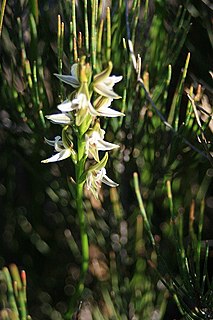
Prasophyllum alpinum, commonly known as the alpine leek orchid, is a species of orchid endemic to Tasmania. It was formerly described as occurring in mainland Australia but has smaller flowers than the species occurring there. It has a single, tube-shaped leaf and up to fourteen green to greenish-brown flowers and grows in subalpine areas.
Prasophyllum australe, commonly known as the southern leek orchid or austral leek orchid, is a species of orchid and is endemic to south-eastern Australia. It has a single tubular, green leaf and up to fifty scented, greenish-brown flowers with red stripes.
Prasophyllum amoenum, commonly known as the dainty leek orchid or Snug leek orchid, is a species of orchid endemic to Tasmania. It has a single tubular, green leaf with a purplish base and between five and twelve light green, dark brown and white flowers. In 2007, the entire population was estimated to be about 600 plants.

Prasophyllum fimbria, commonly known as the fringed leek orchid, is a species of orchid endemic to the south-west of Western Australia. It is a tall orchid with a single smooth, tube-shaped leaf and up to seventy greenish-brown flowers with a white and pink labellum.
Prasophyllum campestre, commonly known as the sandplain leek orchid, or inland leek orchid, is a species of orchid endemic to eastern Australia. It has a single tubular, yellowish-green leaf and up to twenty greenish, strongly scented flowers with red, purplish, brown or white marks. It grows in the drier parts of Queensland, New South Wales and Victoria.

Prasophyllum caudiculum, commonly known as the Guyra leek orchid, is a species of orchid endemic to a small area of northern New South Wales. It has a single tubular, bright green leaf and up to thirty five greenish to reddish-brown flowers crowded along an erect flowering stem. It grows in grassy places near Guyra.
Prasophyllum crebriflorum, commonly known as the crowded leek orchid, is a species of orchid endemic to Tasmania. It has a single tubular, dark green leaf with a purplish base and up to twenty five reddish-brown flowers. It is only known from four relatively small populations growing at high altitudes.
Prasophyllum limnetes, commonly known as the marsh leek orchid, is a species of orchid endemic to Tasmania. It has a single tubular, green leaf and up to thirty five greenish-white flowers with a pinkish labellum. It is only known from a population of fewer than twenty plants growing in a sanctuary near Port Sorell.
Prasophyllum milfordense is a species of orchid endemic to Tasmania. It has a single tubular, dark green leaf and up to thirty greenish-brown, white and purplish flowers. It is a very rare orchid, only found in a single location with a population of around 240 plants.
Prasophyllum parviflorum, commonly known as the slender leek orchid, is a species of orchid endemic to eastern Victoria. It has a single tubular leaf and up to thirty greenish-brown to purplish flowers. Further studies of the species may indicate that some collections currently included may be of a different species.
Prasophyllum perangustum, commonly known as the Knocklofty leek orchid, is a species of orchid endemic to Tasmania. It has a single tubular, dark green leaf and up to fifteen greenish or light brown flowers with a white labellum. It is a very rare orchid with only six plants recorded in 1993.
Prasophyllum readii, commonly known as the Streathem leek orchid, is a species of orchid endemic to Victoria. It has a single, tubular leaf and up to twenty five scented, greenish-brown to reddish-brown flowers with a white or pinkish labellum and is only known from a swamp in the south-west of the state.
Prasophyllum regium, commonly known as the king leek orchid, is a species of orchid endemic to the south-west of Western Australia. It has a single, unusually thick tubular leaf and up to one hundred relatively large, greenish-brown or burgundy-coloured flowers. It is one of the tallest leek orchids, sometimes growing to a height of 2 m (7 ft).

Prasophyllum striatum, commonly known as the streaked leek orchid or eastern hunchback orchid, is a species of orchid endemic to New South Wales. It has a single thin, tube-shaped leaf and up to ten greenish and whitish flowers with reddish or purplish stripes. It differs from other leek orchids in having a very thin leaf and prominently streaked flowers.

Prasophyllum subbisectum, commonly known as the Pomonal leek orchid, is a species of orchid endemic to Victoria. It has a single, thin tubular leaf and up to fifteen small, greenish-brown to brown flowers well-spaced along a thin flowering stem. It is only known from a small area around Stawell.

Prasophyllum tunbridgense, commonly known as the Tunbridge leek orchid, is a species of orchid endemic to Tasmania. It has a single tubular, bright green leaf and up to twenty five relatively large, green to light greenish-brown flowers with white petals and a large white labellum.
Prasophyllum mimulum, commonly known as the highland leek orchid, is a species of orchid endemic to Tasmania. It has a single tubular, green leaf and up to ten greenish-brown to purplish flowers with purple and white petals and a white labellum. It is restricted to subalpine areas of the state.
Prasophyllum murfetii, commonly known as the Fleurieu leek orchid, is a species of orchid endemic to South Australia. It has a single tubular leaf and up to thirty five greenish-brown, pink and white flowers. It only grows around the edges of swamps on the Fleurieu Peninsula. It is similar to P. frenchii and was formerly included in that species.

Prasophyllum basalticum is a species of orchid endemic to New South Wales. It has a single tubular, dark green leaf and up to fifteen scented, greenish-brown to brownish-red flowers with a white and green labellum. It grows in grassy woodland on the Northern Tablelands.














